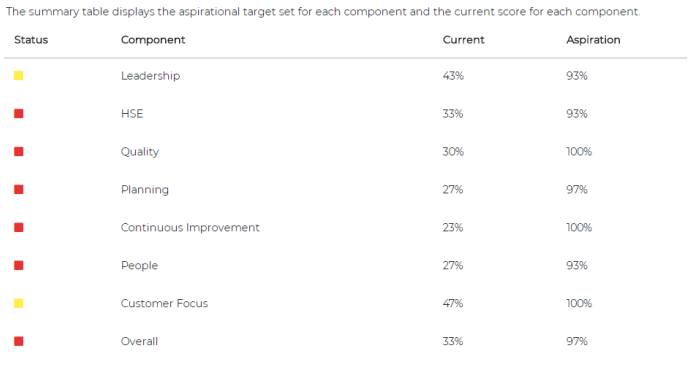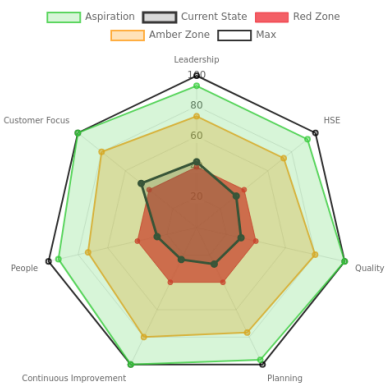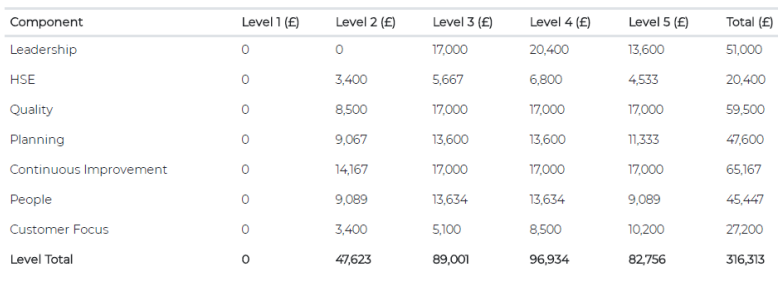R.I.M.E. is a management consultancy specialising in improving manufacturing operations since 1999. They utilise OAG assessments as part of their improvement process. They were called in to evaluate the constraints to growth that their client had.
Their client, Whiteleaf, had recently expanded their product portfolio, adding innovative designs in an attempt to break into new and niche markets. Traditionally, they produced high volume, low variation, repeat order products. The expansion into low volume, bespoke products put pressure on the existing volume-oriented processes. It also demanded greater skills and flexibility from the workforce. As a result, throughput was adversely affected as equipment efficiency and labour productivity reduced. New and old customers alike found lead-times lengthening and delivery promises not being met. Operating costs increased significantly as quality and productivity fell. Raw material stocks increased as the throughput rate declined putting pressure on cash flow.
The owner, an investment company, sought to reverse this situation.
R.I.M.E. was contacted to review and recommend a course of action to turn around the performance of the manufacturing operation.
To conduct an onsite assessment of operations and recommend actions to recover the situation.
R.I.M.E. used the OAG assessment to ascertain the current state of the operation and record the goals set by their client. The assessment exposed the gap and provided an action plan to achieve these goals.
As part of the assessment process, R.I.M.E. interviewed key people from several functions to gather their views on the performance and validated this information before completing the assessment questionnaire. The Finance Director provided gross margin data to enable the financial benefits of closing the gap to be calculated. R.I.M.E. presented their findings to the MD and his senior team before finalising the result and preparing the reports.
The overall assessment result positioned the operation within the Red Zone. This indicates that the processes required for a sustainable manufacturing operation do not exist or are failing to perform at an acceptable level. Of the seven components assessed, five were in the Red Zone representing a significant risk to the business. The other two only just made the Amber Zone.
Whilst leadership was in the Amber Zone, it only achieved a score of 43% which is not capable of delivering the necessary improvements. The report concluded that strengthening the leadership team was seen as essential for turning around the operation.
The HSE process was in the Red Zone. This indicates that neither employees nor managers feel responsible or have a commitment towards safety. The report concluded that this type of culture has an adverse effect on productivity, demotivated employees, caused absence and overtime, and reduced the quality of employees attracted to the business.
Quality in the Red Zone indicates that the processes and systems for managing quality are not performing to a standard that can consistently protect the customer nor contain costs. The report concluded that immediate action is needed to improve the quality process.
Planning is in the Red Zone which indicates that the method of planning materials, process sequencing and delivery are not performing to a standard that can consistently and profitably satisfy the customer. The poor state of the planning process contributed to the adverse throughput, poor equipment utilisation, costs and reduction in capacity. The report concluded that immediate action is taken to overhaul the planning process.
The CI process is in the Red Zone which indicates that there is insufficient knowledge, experience and commitment within the organisation to establish a CI process. The report concluded that without a managed CI process, the operation will not deliver the improvements required to recover. External help will be needed in establishing a CI programme to deliver the urgently required improvements.
People is in the Red Zone which indicates that the process for identifying and addressing the development needs of the organisation is under-performing. The report concluded that up-skilling the workforce and developing the leadership team is crucial to align the organisation with the aspirations of the business.
Whilst CF is in the Amber Zone, it only achieved a score of 47% which is not capable of maintaining the required level of customer satisfaction to attract nor retain customers. The report concluded that immediate action to refocus the operation on satisfying the customer is necessary, and furthermore, that a review of the capability of operation to achieve the strategic goals of the business is required.
Closing the gap between current state and the business aspirations has financial and cultural benefits. Here is an extract of the current overall results and projected financial opportunities.




A full presentation and discussion of the findings was done with a follow up one week later. As a result of the presentation, discussion, executive summary and the 28-page report, the client decided to use it the basis of a strategic review with the executive board.